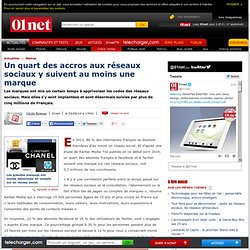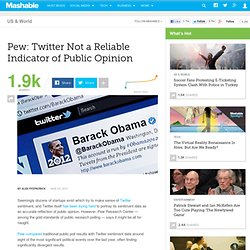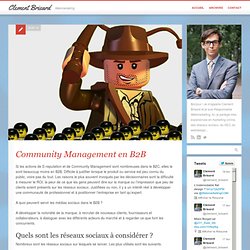

L'infographie du prêt à penser pour les réseaux sociaux (sur Pinterest) (Au secours les clients) Un quart des accros aux réseaux sociaux y suivent au moins une marqueAu secours les clients : 01net le 03/04/14 à 17h01 Les grandes marques ont toutes désormais un compte sur un réseau social.

En 2013, 86 % des internautes français se disaient membres d’au moins un réseau social. Et d’après une étude de Kantar Media TGI publiée en ce début avril 2014, un quart des abonnés français à Facebook et à Twitter suivent une marque sur ces réseaux sociaux, soit 5,7 millions de nos concitoyens. « Il y a une corrélation parfaite entre le temps passé sur les réseaux sociaux et la consultation, l'abonnement ou le fait d'être fan de pages ou comptes de marques », résume Kantar Media qui a interrogé 15 000 personnes âgées de 15 ans et plus vivant en France sur « leurs habitudes de consommation, leurs valeurs, leurs motivations, leurs expositions à l'ensemble des points de contacts médias ».
En moyenne, 22 % des abonnés Facebook et 25 % des utilisateurs de Twitter, sont « engagés » auprès d'une marque. The Top 5 Corporate Twitter Disasters of 2012. Pew: Twitter Not a Reliable Indicator of Public Opinion. Seemingly dozens of startups exist which try to make sense of Twitter sentiment, and Twitter itself has been trying hard to portray its sentiment data as an accurate reflection of public opinion.

However, Pew Research Center — among the gold standards of public research polling — says it might be all for naught. Pew compared traditional public poll results with Twitter sentiment data around eight of the most significant political events over the last year, often finding significantly divergent results. According to Pew, in some instances — Barack Obama's reelection, the first presidential debate and a federal court ruling on California's same-sex marriage ban — the reaction on Twitter was "more pro-Democratic or liberal than the balance of public opinion.
" However, other events — Obama's second inaugural speech, John Kerry's nomination as Secretary of State and Obama's 2012 State of the Union address — elicited a more conservative response on Twitter than they did in opinion polls. Trop de proximité (Tygex sur Twitter) Le buzz à tous prix (Artcile : The 5 Surprising Factors Behind the Most Shared Tweets)
Would you like to know what goes into creating the most popular and successful tweet?

And would you like to know how to use that information to write your very own tweets so they get shared a lot? Well, now you can. Researchers from a new study called “The Pulse of News in Social Media: Forecasting Popularity” say that they can predict 84% of the time what tweet will be the most popular. This was after comparing over 40,000 tweets and narrowing down the factors of the top winners. There are four factors in all: source of the tweet, news category of the tweet, subjectivity of the tweet language and how popular the name is in the tweet. Let’s look at the four factors so I can help you create your very own popular tweets—and then I’ll introduce you into a fifth factor that will make your tweets even better.
Here we go. Factor #1: The authority that posts article The first big find by the researchers is who posts the tweet. What does this tell us? There are three ways you can do this: Conclusion. (Article bullshit bingo) Community Management en B2B. Si les actions de E-reputation et de Community Management sont nombreuses dans le B2C, elles le sont beaucoup moins en B2B.

Difficile à justifier lorsque le produit ou service est peu connu du public, voire pas du tout. Les raisons le plus souvent invoqués par les décisionnaires sont la difficulté à mesurer le ROI, la peur de ce que les gens peuvent dire sur la marque ou l’impression que peu de clients soient présents sur les réseaux sociaux. Justifiées ou non, il y a un intérêt réel à développer une communauté de professionnel et à positionner l’entreprise en tant qu’expert.